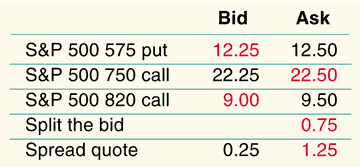Q&A

Futures For You
Inside The Futures World
Want to find out how the futures markets really work?
DeCarley Trading senior analyst and broker Carley Garner responds to your questions
about today's futures markets. To submit a question, post your question
at https://Message-Boards.Traders.com. Answers will be posted there, and selected questions will appear in a future issue of S&C.
Splitting The Bid?
Option traders often talk about “splitting the bid” or “midpoint”; what are they referring to?
All markets, whether we are talking about cars, houses, groceries, stocks, currencies, futures, or options, have two prices at any given time. There is a price at which an asset can be purchased and one at which it can be sold. In the world of trading, the difference is known as the bid/ask spread. The spread between the two prices is the compensation that the executor requires to accept the risk involved in making a market.
For instance, your local grocer buys products to stock his shelves at a wholesale price, only to turn around and sell it to you at a retail price. The difference between the price that he pays for items and what he sells it for is referred to as the margin in retail, identical to the bid/ask spread in the financial markets. The grocer is accepting the risk of not being able to sell the items purchased at wholesale and therefore must charge a markup in order to compensate him for his efforts.
Similarly, market makers in the financial markets are attempting to profit from the bid/ask spread. For most, the goal is to execute a trade by taking the opposite side of an order and immediately offset price risk by exiting the position. Assuming no price change, their profit on the transaction is equal to the bid/ask spread. As you can imagine, in some of the less liquid markets it is more difficult for market makers to offset their positions and thus their risk. In such cases, the bid/ask spread is wider in order to allow for proper compensation of the risk for taking the other side of the orders executed by retail traders.
Option traders are typically more aware of the bid/ask spread than futures traders are. This is because options aren’t as liquid and therefore come with higher spreads. For instance, an emini Standard & Poor’s futures contract typically has a bid/ask spread of a tick (0.25), which is equivalent to $12.50 to a trader. However, an at-the-money option tends to have a spread of (0.50) during liquid market hours and about (2.00) in the overnight session. A spread of 0.50 represents $25 to a trader and is relatively manageable. Conversely, a spread of 2.00 or $100 can eat away at a trading account.
Let’s take a look at an example. If an emini S&P 500 option trader is interested in purchasing an 800 call, his broker (or his quote vendor) may tell him that it is 13.00 bid at 13.50. In other words, if the trader placed an order to buy the 800 call at the market price, he would be filled at the ask, 13.50; if the order was to sell at the market price he would be filled at the bid, 13.00.
However, a savvy trader (and one that isn’t pressed for time and concerned about the risk of substantial market moves) may put a limit order to either buy or sell at 13.25. Doing so is asking that the market maker come to him and in the normal ebb and flow of the market the order is likely to be filled. This process is known as splitting the bid or picking the midpoint.
Not only can splitting the bid be a viable approach to trading outright options, but it is also commonly used in option spread trading. Similar to the bid/ask quote that your broker will give you when buying or selling a single option, she will give you a price at which you can buy or sell a spread. An option spread is priced as a package as opposed to each individual leg separately.
In early March, a trader looking to buy an emini S&P 750 call, sell an 820 call, and then sell a 575 put as a three-legged spread would have faced a bid/ask spread of 0.25 at 1.25. A seller of the spread would receive 0.25 in premium while the buyer would pay 1.25 if entered at the market price. If the premium paid for the long options exceeds that of which is being collected for the short options, the trader is buying the spread. If the value of the combined short options is higher than that of the long, the trader is said to be selling the spread. In this example, the trader is looking to buy the spread because the price of the long 750 call exceeds that of the combined value of the short 820 call and 575 put.

FIGURE 1: SEQ TABLE/ARABIC 1. A trader wishing to buy this spread would be paying the ask (or trying to split the bid) of the spread.
Splitting the bid in this instance would mean placing a limit order at 0.75 to either buy or sell the spread depending on the trader’s intention. With a spread ticket such as this, it is an all-or-nothing proposition. The trader is requesting to be filled on all three options or none at all at the stated package limit price. Each individual option involved in the spread also has its own bid/ask. See Figure 1. Splitting the bid is a great idea for those who can accept the risk of missing a trade. While in most instances a fill will be possible with this strategy, a fast-moving market may cause the order to go unfilled.